During her long reign, Elizabeth II visited Morocco only once, from October 27 to 30, 1980.
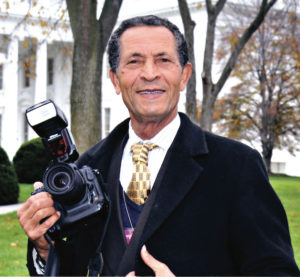
Welcomed by Hassan II, the queen, accompanied by her husband and entourage, visited Rabat, Marrakech, and Casablanca. For the royal couple, it marked the end of a long Mediterranean tour, which included state visits to Italy, the Vatican, Tunisia, and Algeria.
Dubbed the « tour from hell » by English tabloids, Elizabeth II and Prince Philip’s stay in Morocco was marked by a series of mishaps
Called the “tour from hell” by English tabloids, Elizabeth II and Prince Philip’s Moroccan visit was fraught with slip-ups, last-minute program changes, and delays. One notable incident involved the queen waiting over half an hour in her car before a banquet held in her honor.
An unpredictable king
The tone was set right from the arrival of the British royal couple at Rabat Airport, where they waited for a good half-hour, as Hassan II was late to greet them. In full ceremonial attire, the Moroccan monarch, accompanied by Crown Prince Sidi Mohammed, welcomed his distinguished guests, expressing his desire to modify the official program.
According to journalist Robert Hardman, a British royal family expert, « This led to a major backstage argument between the chief aides of the two monarchs, » as recounted in his documentary Our Queen, a British royal family expert, in his documentary Our Queen, aired in 2013 on the British channel ITV.
Buckingham Palace insisted that the prearranged plans (set well in advance) be respected. In vain. Hassan II, partly due to attempted coups and assassination attempts he had faced less than ten years prior, canceled or postponed lunches and receptions without notice and was wary of long official processions.
Despite the announced upheaval in the schedule, Elizabeth II maintained her legendary composure. Perhaps because her sister, Princess Margaret, had warned her, saying, “Going to Morocco is more like a kidnapping; you never know where you’re going or when…”
The queen greeted the crowds in Rabat, standing alongside Hassan II in the procession up Boulevard Mohammed V, after delivering a speech to the parliament in a joint session of both chambers.
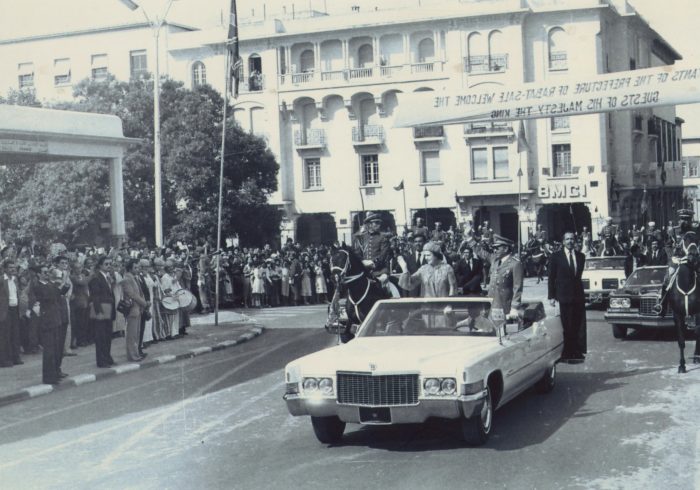
But she is caught off guard. A photo captures the moment when the queen, seated in her car, checks her watch with impatience: she’s left waiting 32 minutes outside the royal palace in Rabat, where a dinner in her honor is scheduled.
Discreetly, as journalist Robert Hardman notes in his documentary, “the Duke of Edinburgh’s private secretary managed to pass a dry martini to the queen through her car window.” A small gesture to ease the wait for the queen before the reception, attended by Crown Prince Sidi Mohammed, Princesses Lalla Meryem, Lalla Asma, Lalla Hasna, and Prince Moulay Rachid.
The following day, a similar scenario unfolds. Officially, a lunch is scheduled at 1 p.m. at the Jnane Lekbir palace on the road from Fes to Marrakech. Yet, once again, Hassan II changes plans and invites his guests to a “party.” The royal convoy, already running significantly late, heads toward Ouarzazate, stopping at Aït Ourir at the foot of the Atlas Mountains, about 30 kilometers southeast of Marrakech. Tents have been set up there to welcome the guests. Along the way, it’s said the king had the queen change cars seven times for security reasons…
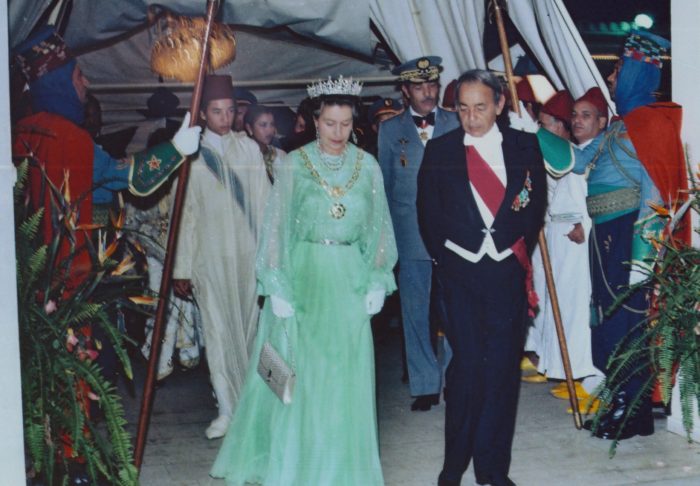
An angry queen
Once there, the lunch is delayed even further. After long displays of tbourida, accompanied by the rhythms of ahwach and ahidous, the méchoui (roast) finally begins shortly before 4 p.m.
Breaking from British royal protocol, Hassan II reportedly tried to seat himself between the queen and her husband, which infuriated the Duke of Edinburgh—though the situation was promptly corrected after this incident.
Hassan II then retreats to a private tent to make phone calls and give instructions, leaving the Queen, Prince Philip, and his cousin Simeon of Bulgaria to watch the show alone: domesticated falcons hunting a flock of pigeons released especially for the occasion.
The British press of the time gave extensive coverage to the events. Elizabeth II, out of patience, showed signs of frustration, fidgeting with her purse and hat and tapping her foot. « Keep your cameras rolling; you might witness the biggest walkout of all time, » she reportedly told photographers, according to a witness. The British tabloids eagerly seized on the drama, with The Sun headlining « The Angry Queen » and The Mirror declaring « What an Insult. »
British fair-play
But Elizabeth II’s patience was tested once more the following day. A farewell lunch was scheduled on board the Britannia, the Queen’s yacht, docked in Casablanca. « The chamberlain came forward and said that the king would be grateful if the banquet could be postponed a few hours, » recalls former Foreign Secretary Douglas Hurd, who accompanied the Queen on her visit, in the documentary Our Queen.
« The real reason was that he was moving from one palace to another for security reasons, » adds the diplomat, who was then Minister of State for Europe. Unfazed, the Queen calmly explained that the event could not be delayed: « I will completely understand if His Majesty is late. »
As it happened, Hassan II was only… 54 minutes late and arrived with more members of the royal family than anticipated. « We had to search for extra place settings, » Lord Hurd explains, adding that the king « also brought coolers filled with food, fearing someone might attempt to poison him. »
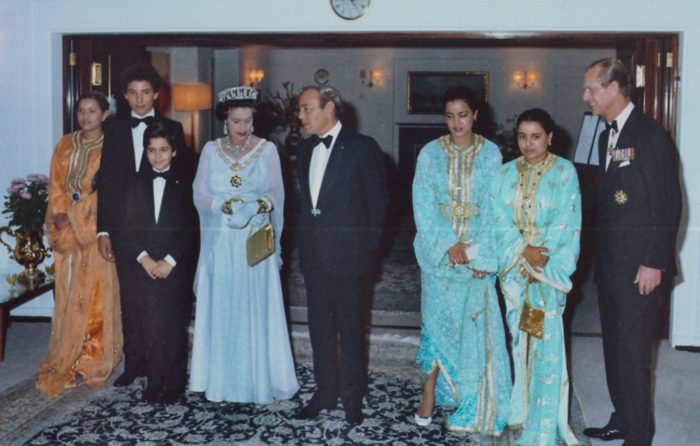
To top it off, Hassan II himself was reportedly furious that day, feeling that the honorary decorations awarded to the crown prince and his elder sister Meryem (the Royal Victorian Order) were not prestigious enough, as noted by the British diplomat.
The late king even allegedly threatened to cancel a trade deal, ordering the British ambassador to leave the country the following morning. “I consulted Prince Philip, who burst out laughing and told me, ‘Do absolutely nothing and wait until tomorrow,’” recalls Douglas Hurd. True enough, by the next day, the storm had blown over, and the royal visit was complete.
Curiously, upon her return to Buckingham Palace, the queen promptly sent a thank-you letter to Hassan II, praising his “exceptionally warm and generous hospitality.” She added with dry humor, “We were especially touched by the way Your Majesty took such a personal interest in our visit’s schedule.” In this way, she deftly avoided a public rift with one of the Muslim world’s most pro-Western nations amid the Cold War context.
Never without my bed
Seven years later, it was Elizabeth II’s turn to host Hassan II in Great Britain. Ever unpredictable, he arrived in England a day before the official start of his visit. The king and his entourage, estimated at 150 people, reserved three floors of the Grand Hotel in the seaside resort of Brighton. « One night alone cost at least $81,000, » noted the American news agency Associated Press (AP) which reported other juicy details.
Hassan II even brought his own bed to the hotel. « It’s not that grand, » the hotel manager told AP. « Our beds are 6 feet wide, and this one is a humble 5 feet. But what it lacks in size, it makes up for in energy, as it’s equipped with an electronic device,” which the manager speculates is used to move the bed to « rock » the king.
The day after his arrival, Hassan II took the train from Brighton to Victoria Station in London, where he was welcomed by the queen in a ceremony officially marking the start of his four-day visit.
« Look at these people, my children, they work with order and punctuality. Don’t argue if they decide you should stand in a specific place, » Hassan II told the Moroccan journalists
Mohamed Maradji, the personal photographer to the monarch throughout his reign, recalls Hassan II’s journey to London with particular fondness. Before boarding the queen’s carriage, the king gathered the accredited Moroccan journalists for a briefing. Dressed in a white jellaba, the monarch began: “Look, my children, these people work with order and punctuality. Don’t argue if they decide you must stand in a specific place, because they know what they’re doing. They’ve planned everything so that everyone can accomplish their mission as they should,” Maradji remembers. The British services had arranged a balcony at a London apartment specifically for him, allowing him to capture the two monarchs together.
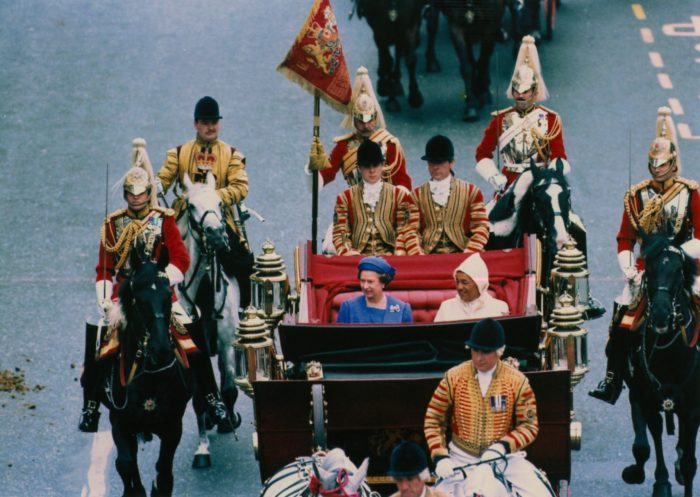
The queen departs
Mohamed Maradji recalls with emotion “the thousands of British citizens who traveled hundreds of miles and waited in long lines to pay their last respects to their queen” following the passing of Elizabeth II.
These scenes reminded the photographer of “that morning on July 23, 1999, when, as I was driving from Casablanca to Rabat, I saw thousands of Casablancans gathered along the road, hitchhiking to pay their final respects to their monarch.” Like Elizabeth II’s one official visit to Morocco, Hassan II made only one official trip to the United Kingdom.
However, Elizabeth II’s son and heir to the throne, the Prince of Wales (now Charles III), made several visits to Morocco. His first was in 1996, which was described as something of a “mystery visit.”
True to form, Hassan II altered the prince’s schedule at the last minute. The Prince of Wales toured Al Akhawayn University in Ifrane before a planned audience at the Rabat palace was transformed into a hunting excursion.
The heir’s trip had fewer twists than his mother’s visit 16 years prior. He had the chance to explore the medina of Fes and then toured the Hassan II Mosque in Casablanca.
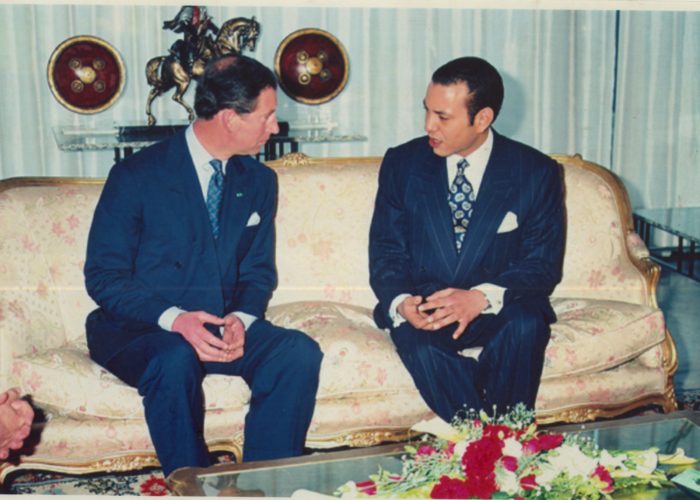
Prince Charles made another visit in April 2011 with his second wife, the Duchess of Cornwall, Camilla Parker Bowles. The more limited program included visits to the Kasbah of the Oudayas and the ruins of Chellah in Rabat.
This final visit, focused on interfaith dialogue, climate change, and trade, was supposed to conclude in the southern part of the kingdom. However, the planned excursion was ultimately canceled due to sandstorms, just as the winds of the Arab Spring were sweeping through the region.
Written in French by Jassim Ahdani, edited in English by Eric Nielson



